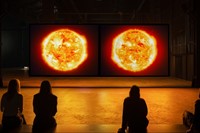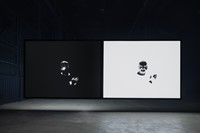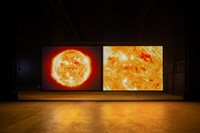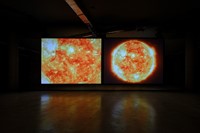“When you think of blackface, we have to remember how much popular culture is shaped by it,” the British director and artist says following his personal new commission on show in Rotterdam
On the first day of 2023, the copyright of Alan Crosland’s venerated yet troubling classic, The Jazz Singer, finally expired. A little over 95 years have passed since its pioneering introduction of synchronised sound – and yet, for the majority of that period, praise of its technical innovation has routinely outshone any criticism for its use of blackface. In 1996, the film was officially admitted into the US National Film Registry as "culturally, historically or aesthetically significant”, joining the likes of The Birth of A Nation (1915) and Gone With The Wind (1939), as canonised classics latterly exposed for their overtly racist imagery. Like those films, The Jazz Singer marked the beginning of a tradition within Hollywood of using caricature and cliché in their portrayal of Blackness, a tradition that dates back to vaudeville and minstrel shows and continues to this day.
Given this complex legacy, it’s little surprise that artist and director Steve McQueen has been drawn to the film for so long. “It’s been about 20 years that I’ve wanted to work with this material,” he tells AnOther at the International Film Festival Rotterdam, where his film, Sunshine State, was a major highlight of this year’s programme. “It was one of those situations where the tail wags the dog,” explains McQueen. “I wanted to work with it because I wanted to erase Al Jolson.” One of the most acclaimed actors of his day, Jolson plays the film’s lead, Jakie Rabinowitz, who defies the wishes of his orthodox Jewish father by anglicising his name to Jack Robin and pursuing his dream of singing jazz. Shortly before going on stage to rehearse his breakthrough Broadway act, Jack applies blackface, and again in the film’s finale, as he performs in front of a live audience.
In Sunshine State, a 30 minute film projected onto two adjoining screens, McQueen has at last voiced his response. Sitting in front of his dressing room mirror, we watch as Al Jolson’s character is literally erased from the picture. McQueen digitally manipulates the footage of applying blackface to invert its effect: with each stroke Jack’s sponge now wipes away his physiognomy until it disappears entirely. The sequence is then shown in reverse, so that by removing the make-up, Jack returns to a visible state. On the adjacent screen, McQueen shows the same scene, but drained of all colour by converting the footage into negative, thereby turning white into black and visa-versa.
But perhaps the most haunting part of the work comes in the form of the artist’s own narration, as he recounts a story told to him by his father shortly before his death. McQueen explains how his father arrived in Florida (nicknamed The Sunshine State) from the West Indies to work as an orange picker. After sneaking out of his camp one night with two fellow workers and heading to a nearby bar, the three Black men are refused service, leading to an altercation and ultimately the murder of his two acquaintances. The narration is repeated four times by McQueen, who omits new lines in each re-telling until he reduces the story to a series of single, devastating words. The effect is, as McQueen explains, “that you never hear the same story twice,” but the technique also follows the same idea of mirroring and erasure – not just of images, but words.
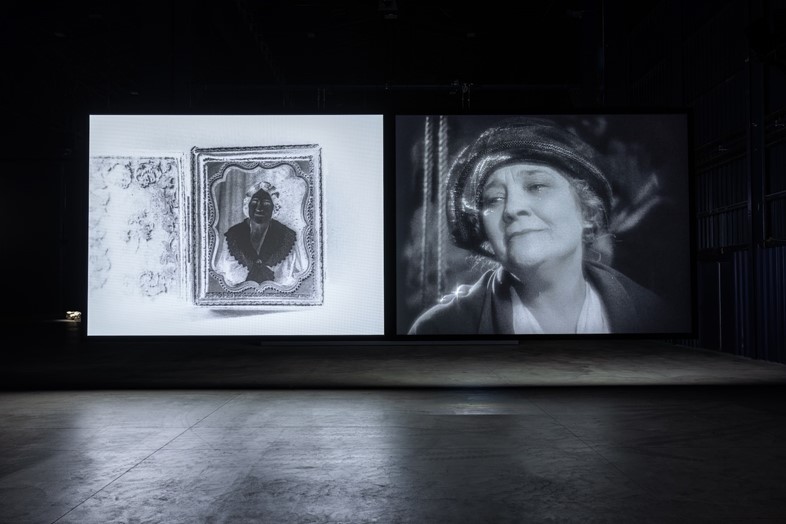
The combination of his father’s story with that of Jack Robin is, in the artist’s view, “about protection.” “All I know is at that moment, what my father told me was when he knew he was going to die,” says McQueen. “He'd been carrying it around for a long time and I'd never heard it until he told me – why now?” Just as Jack Robin’s father tries to dissuade his son from abandoning tradition for reasons he believes represent his best interests, the making of Sunshine State forced McQueen to acknowledge that his father had withheld this particular anecdote for virtually his entire life out of a duty of protection.
This symmetry between two fathers is one of several binaries that define Sunshine State. McQueen’s use of two channels accentuates these dualities, not only positive and negative, erasure and appearance, white and black, but in his interspersed shots of the sun’s seething surface, the juxtaposition between no colour and the source of all colour. Al Jolson’s use of blackface only adds to these beguiling polarities. On the one hand, blackface enables him to embody so-called ‘Black’ qualities of rhythm and soul required to perform jazz. On the other, blackface allows him to become ‘white’, by concealing his Jewish identity and aligning himself with the long-standing white American tradition of demonising the supposed ‘otherness’ of the Black community.
The film’s presentation in Holland feels particularly relevant. Zwarte Piet, or Black Pete, is a centuries-old annual celebration in the Low Countries that accompanies the feast of St Nicholas, during which adults apply blackface to resemble the Black Moor who accompanied the saint from Spain. For McQueen, who lives in Amsterdam with his family, this cultural context only added to the film’s importance. “I remember my daughter going to school and having these people in blackface and I just thought, this is really strange. I’d often go to London to get away, and it got to a point where my wife and I petitioned our school to get rid of [Black Pete] for their kindergarten.” Yet for McQueen, the legacy of blackface and The Jazz Singer continue to permeate the everyday in increasingly veiled and insidious forms. “When you think of blackface, we have to remember how much popular culture is shaped by it,” he says. “Disney doesn’t want to admit it, but Bugs Bunny, Mickey Mouse, Felix the Cat – they’re all based on minstrel shows.”

